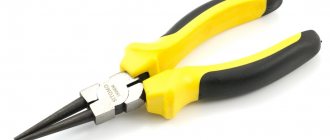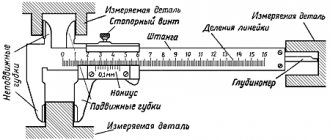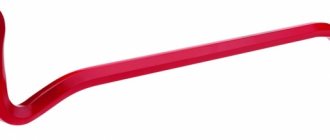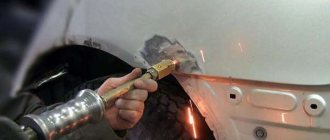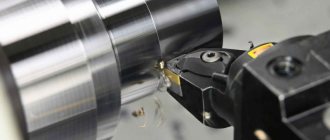An airbrush is a pneumatic painting tool designed for applying paint by spraying.
Its feature that immediately catches your eye is its miniature size, comparable to a ballpoint pen or marker.
Almost all existing types of airbrushes are used in airbrushing - one of the techniques of fine art, used in body art, painting on the walls of buildings, to create drawings on various surfaces.
Moreover, it is quite difficult to achieve high results without using airbrushes.
Purpose and principle of operation
The airbrush is used primarily for fine painting work.
The thickness of the lines applied by this tool may not exceed the thickness of a human hair, which makes it possible to paint any surface with high precision in the application of figures and image elements.
The word “airbrush” means applying drawings using air, and there are several types of it, depending on the color used as a background and the type of paint.
Airbrushes are most often used to create designs on body parts of cars, motorcycles and almost any equipment.
Airbrushing is used in painting various dishes, New Year's toys, smartphones, various sizes of souvenirs and similar products.
Retouching, restoration of photographs, creation of paintings, painting of nails, individual areas of the body, including makeup, and the whole body - all this can be done by a good master with an airbrush in his hands.
In addition to painting, this tool is also used for priming with appropriate mixtures based on resins and enamel.
The airbrush is capable of applying material in a thin layer, which is its advantage over the same spray guns.
The work uses the pneumatic spraying method, when an air flow whose pressure exceeds atmospheric pressure, when passing through a narrow hole, forms a jet.
At the same time, a near-jet vacuum, otherwise called low vacuum, is formed around the jet, and this process occurs due to the high speed of movement of the air mass.
Airbrushes require a source of compressed air to operate, which is a compressor.
It is possible to operate this tool without a compressor, for example, using a compressed air cylinder.
What materials can be painted with an airbrush?
An airbrush is actively used to apply a coloring composition to any materials on which the paint can adhere.
By applying a liquid paint coating to a surface using this tool, you can achieve, while maintaining the complete smoothness of the first coating, smooth color transitions and incredible decorative effects, including 3D.
The effect of a rough texture while maintaining the specularity of the surface is especially impressive.
The basis for airbrushing can be wood and plastic, metal and glass, textiles, paper and even human skin.
If there are any restrictions in this matter, they relate to compatibility with the material of the selected paint.
What kind of paints do airbrushes use?
When working with an airbrush, the following groups of paints are used:
- Water-soluble acrylic compounds.
- Basic urethane options.
- Multicomponent multistage compositions.
Acrylic paints made on a water basis have gained popularity, among the advantages of which are a wide color palette, a high level of hiding power and adhesion, non-toxicity, and the ability to use on any type of surface.
The direct competitor of this paint is nitro enamel, which is used when working with automobile bodies and has a high drying speed.
In addition, it can be used to create a translucent fill or a perfect thin line.
Areas of use
The devices use finely dispersed paints that break down into microparticles during spraying. The compositions can be produced on various bases, which allows airbrushes to be used for many tasks.
Using such devices, coating can be applied to various types of materials:
- metal;
- paper;
- wooden;
- fabric;
- ceramic;
- plastic.
Airbrushes are often used to create complex, detailed designs on a car's body.
There are also devices used for applying patterned manicures, make-up and make-up. Varieties made from food grade steel help confectioners decorate culinary products.
Device and characteristics
The airbrush is a cylindrical tool consisting of the following elements:
- The nozzle is a smooth outlet hole, which, accordingly, provides an even stream.
- The needle is located in the center of the nozzle, opens and closes the outlet, and a special sleeve holds it in the correct position.
- Paint reservoir - usually located on the top or bottom of the tool.
- Needle position regulator - allows you to adjust the amount of paint sprayed.
- Trigger - the starting lever that puts the tool into action.
- Air supply valve and air hose – for connecting a compressed air source.
Individual parts may differ in both shape and location, however, this does not in any way affect the principle of operation of the tool.
Material
Metal and composite materials are used to make the airbrush body.
The tank can also be metal or made of transparent plastic.
The issue of storage and transportation is solved by the plastic case included in the delivery package.
The needle and nozzle are often coated with Teflon.
Needles and nozzles
One of the most important characteristics of airbrushes is the diameter of the nozzles and needles, depending on which certain artistic works are performed.
The nozzle dimensions can be in the range of 0.15 - 0.6 mm, where:
- 0.15 – 0.18 mm – used to obtain highly detailed images and form extremely fine lines. For these purposes, only finely dispersed paints of the highest quality are suitable, since otherwise there is a high risk of failure of the instrument itself, or the design may be distorted.
- 0.2 – 0.3 mm are universal diameters that are equally well used for applying a background to various objects and clearly drawing small details.
- 0.4 - 0.6 mm - used for applying not only paint, but also varnish, primers, suitable for large-scale artistic works.
The characteristics also include the type of connection of the nozzle with the main part of the tool, it can be:
- Fixed, threaded.
- Fixed, conical (conical) self-centric.
- Fixed, combined self-centric.
- Floating self-centering.
Dimensions and weight
The total length of the airbrush is usually about 150 - 267 mm, width 41 - 144 mm, depending on the location of the tank, height 13 - 90 mm.
The instrument weighs on average 0.3 – 0.68 kg.
The tank capacity is about 0.0015 - 0.009 l.
Types of air supply and operating pressure
Airbrushes, depending on the model, require a compressed air supply under pressure from 1 to 3.5 atmospheres.
The flow rate of this air is usually from 9 to 57 liters/min., and according to the type of air flow passage they are distinguished:
- Flow models - with a constant outlet of air flow to the outside without adjusting its quantity.
- Lockable airbrushes - with air flow coming out only when the trigger is turned on, with adjustment of its quantity.
The air is usually introduced from the bottom of the tool, as opposed to the paint material.
Depending on the location of the paint container, the material supply is:
- Gravity - the tank is located on top, which allows the paint material to fall into the mixer under the influence of gravity. Top feed does not require high air pressure.
- Siphon - the tank is located at the bottom, which means we are talking about a tool with a bottom feed. Here, higher pressure is required, since air is supplied to the tank and pushes the paint upward into the mixer. The advantage is the larger capacity of the tank compared to the previous option.
- Hybrid - combines the two options described above, that is, the tank can be either at the top or at the bottom. The design provides a switch between them, and some models are capable of working with two tanks simultaneously.
NOTE:
There are airbrushes with a tank located on the side (right or left), but they also belong to gravity or siphon options.
GENERAL RULES
When purchasing a confectionery airbrush, it is very important to decide for what purpose it is needed, and be sure to take into account the work experience of the future owner. Because a beginner, having bought an expensive model, will not be able to fully take advantage of all the functions of an ultra-modern airbrush, and this can significantly complicate his work and even interfere with drawing. Inexpensive models are suitable for work where high precision of lines and the creation of a complex pattern with drawing of small elements are not required.
GOST
For pneumatic spray paint sprayers, the technical specifications are contained in GOST 20223-74, however, its validity has now been discontinued.
Marking
Typically, there is a marking on the side of each airbrush, which may contain information about the technical characteristics, country, date of manufacture and/or manufacturer.
There is no unified marking system for airbrushes, so the decoding of the inscriptions on each specific model must be looked at in the corresponding manufacturer’s tables.
Meet airbrush!
Airbrushing began to gain popularity back in the last century, and in recent years the use of this technique to give an original look to cars has become very common. Using an airbrush (“air brush”), you can decorate a car body with images of any complexity, opening up the widest possibilities for realizing your design ideas and fantasies. It is thanks to airbrushing that today we can be impressed by spectacular cars, decorated with exotic landscapes, unusual animals, all kinds of symbols, images of characters from our favorite books and films. The main advantage of this technology is its ability to turn any standard vehicle into an exclusive car.
To colorfully transform a car you will need certain skills and tools, special attention will need to be paid to:
- airbrush equipment;
- a set of airbrush tools and accessories;
- acquiring knowledge about the technique of applying paint, the use of all necessary tools, the art of drawing, and the basics of painting.
A wide range of equipment and tools for airbrushing and other painting works can be found here: https://tck-market.ru/shop/okrasochnoe-oborudovanie/
Airbrushing can be turned into a hobby, decorating your own car, motorcycle or friends' cars, but mastering this technique may well encourage you to create a fairly profitable business. But in any case, saving on equipment and consumables will be inappropriate. It is better to immediately purchase high-quality, albeit expensive, dyes, equipment, and accessories - this will guarantee a decent level of your work.
Types of airbrushes and their prices
Airbrushes are divided into types according to several parameters simultaneously.
For example, based on the method of mixing air with the paint material, the following types of mixers are distinguished:
- External - two streams are mixed from the outside, have a simple design, are easy to use and configure. On the other hand, such models are only suitable for working with large areas. Due to its simplicity and unpretentiousness, such an instrument is good for novice craftsmen, and therefore can be considered an amateur one. Cost 700 – 1500 rubles.
- Internal – suitable for painting hard-to-reach places, characterized by a high-quality final result of the work. It should be noted that the design with internal flow mixing requires careful handling, since it does not have a significant margin of safety.
An internal spray airbrush is a complete professional equipment for precision work.
In particular, we are talking about a hybrid design that allows you to install the paint barrel in a position convenient for efficient work, and also provides a higher output pressure.
The cost is often not less than 1600 rubles.
According to the type of control, airbrushes are:
Single (single) action
Models that feature external spray without a needle, internal spray and external spray with a needle.
The operating mode is controlled by adjusting either the ink channel or the air channel.
In the first case, the air flow blows constantly and remains unchanged, and the coloring material is sprayed when the trigger is pressed.
In the second case, when the trigger is pressed, an air flow is formed, creating a zone of reduced pressure into which the paint is drawn, followed by spraying.
It was airbrushes with air channel adjustment that became widespread, displacing the original design of this tool from the market.
Double action
Options for smooth independent (manual) and fixed (dependent, automatic) action.
In the first case, control is carried out both through the ink and air channels, i.e. When you press the trigger, only paint is supplied, and to release air, the trigger must be pulled back slightly.
In the second case, it is impossible to independently adjust the flow of air and paint, due to the fact that the two actions are combined into one, where when the trigger is pulled back, air and paint are simultaneously supplied.
Independent action
With a fully controlled work process, which allows you to apply some additional effects.
It is considered a universal option.
Depending on how the airbrush is put into operation, it can be:
Button
This is a trigger version, shaped like a ballpoint pen, in fact, during operation it is held in the hands in the same way, while the start button is on top.
Kurkovy
The shape resembles a pistol, and accordingly it is somewhat larger in size.
A pistol airbrush is similar in appearance to a classic airbrush.
Airbrushes can be equipped with pre-setting mechanisms; according to this parameter, the tool is divided into the following types:
Pre-set Handle Set
These are options with a mechanism for limiting the supply of coloring material.
The design provides a mechanism for limiting needle movement.
Line Adjustment Assembly
Preliminary adjustment of the material supply is provided here.
Only airbrushes with bottom material feed are equipped with this mechanism, however, the tool itself is very easy to operate.
There are also models with pre-set air supply in the form of an additional air valve.
The most widely used pneumatic tool requires connection to a separate compressor equipment with a receiver, or some source of compressed air, however, there is an electric version of the airbrush.
In the latter case, we are still talking about a pneumatic device, but it comes with a small, sometimes even miniature compressor without a receiver, powered from a regular outlet.
Almost always this is a Chinese low-power tool, however, for some purposes, for example, for painting nails, it is quite suitable.
Mini airbrush
This is mainly the name given to amateur models of this instrument, the body of which can be made of either metal or plastic.
There are no special differences from the standard options here, except for the price and a modest set of components.
The cost of plastic copies starts from about 600 rubles. for the whole set, in fact it is a good toy for training and developing the necessary skills.
Metal mini airbrushes, as a rule, are ordinary models that are slightly smaller in size; the price of such options is approximately 4-10 times higher than plastic ones.
Typically, an airbrush can be used to perform a wide range of jobs, however, some manufacturers make specialized models for specific tasks. As an example, the following options can be given:
Automotive
A tool that requires the purchase of a separate high-performance compressor with a receiver, designed specifically for painting a car body.
Food
The confectionery airbrush is designed to work with special food dyes; it is used to decorate cakes and pastries.
Airbrush for makeup
The diameter of the needles in cosmetic airbrushes is very thin, so such a specialized tool is more sensitive to the coloring material.
This is how the models for using water-based and silicone-based paints differ.
The container for paint is also noticeably smaller than that of ordinary specimens; for cosmetic procedures, it is enough to drop 3-5 drops of dye into the tank.
The cost of such options can be more than 9 thousand rubles.
Principle of operation
The device is connected to the compressor through a hose. By pressing the trigger (start button), air is supplied, which captures the coloring composition from the airbrush tank as it moves.
The resulting mixture is sprayed out of the nozzle under pressure, forming something like a torch. The output dye particles are very small and therefore are applied more evenly to the surface without creating roughness.
A special needle serves as a shutter for the nozzle; when pressed, the release lever moves it away, passing the air-paint mixture through the gap. Increasing the impact on the trigger increases the size of the exiting torch.
Expert opinion
Torsunov Pavel Maksimovich
Dye and air supply options determine the different types of devices.
How to choose an airbrush?
When choosing an airbrush, you should remember that a beginner does not need to purchase an expensive model.
The fact is that you have to master the tool, and this requires time to gain experience, during which mistakes are inevitable.
Therefore, it should not be a pity to damage the tool, especially the needle or nozzle, in the sense that it is better to start from simple to complex, and not vice versa.
NOTE:
Along with the tool, you will have to purchase a compressor; for home use, it is recommended to purchase a membrane model, one of the advantages of which is ease of control.
You can find a complete set including a compressor on sale.
A professional who has experience using airbrushes, for example, for painting cars, will need a reliable and high-quality tool.
Professional-level models are characterized by the complexity of setup and management, the presence of additional options that allow you to perform the work as accurately and efficiently as possible.
For example, a feed limiter will prevent the formation of unevenness and blots by limiting the maximum line size.
If the choice falls on an airbrush with a pressure regulator, this will eliminate the need to constantly run to the compressor during work to set it up.
Choose an airbrush, preferably from well-known manufacturers, in specialized stores, where you can get good advice from a salesperson who will help you choose a model for specific tasks and introduce you to the nuances of using and caring for the tool.
It is important to pay attention to the equipment, conditions and warranty period, since the cost of even individual elements of a good tool is quite high.
Tips for use
To get a beautiful and high-quality drawing, you should know about some tricks of using an airbrush:
- During the working process, the unit should be held at an angle of 90° to the surface. When applying horizontally, spray must be at an angle greater than 45°. This will allow the dye to be distributed evenly.
- The size of the gap between the canvas and the device affects the thickness and quality of the lines, and the intensity of the color. It is necessary to change the distance smoothly, without making sudden movements.
- Spills should not be cleaned up immediately. It’s better to wait until they dry and sand them with fine sandpaper, and then correct the design.
- To speed up the creative process, you should prepare several tanks with different colors of paint. If you need to change the shade, you do not have to rinse the container; just clean the unit itself and attach another container with dye.
Using an airbrush, you can quickly cover a large area, economically using the coloring composition. The coating will be smooth and beautiful. By experimenting with the material feed settings, you can create realistic images on various products and surfaces.
What you need to know about airbrushes?
An airbrush is a high-precision tool that requires proper care and storage.
To clean the tool, you need to rid it of any remaining paint, remove the needle, and then wipe it towards the sharp end.
Next, you should pour a small amount of cleaning solution (you can use WD-40) or just water into the airbrush, pass it through the nozzle, and then blow it with air.
After this, wipe the paint container with a clean and dry cloth.
Next, unscrew the safety cap, wipe it with the above solution, and then screw it back on.
At the end of cleaning, insert the needle back and perform repeated blowing.
The needle can be stored either assembled or separately.
Attention!
It is not recommended to store the airbrush and its components in liquid, because... The gaskets may swell; to prevent this from happening, you can remove them first.
Cleaning the airbrush is a mandatory procedure even after short-term use.
It is this action that will ensure long-term preservation of the tool’s performance, durability and wear resistance.
Story
The first airbrush was patented in 1876 (patent number 182389 dated September 19, 1876) by Francis Edgar Stanley of Newton, Massachusetts. Stanley and his twin brother later invented the process of continuously coating photographic plates (Stanley Dry Plate Company), creating the Stanley Steamer steam car.
The airbrush was subsequently improved by Abner Peeler. This airbrush used a hand-held compressor and was patented "for watercolor painting and other artistic purposes." It was a fairly crude product, consisting of many spare parts found in a jewelry workshop such as old screwdrivers and welding torches. He spent 4 years until he developed a working version. The patent for the design was sold in 1882 to Liberty Walkup, who taught airbrushing techniques to the American impressionist Wilson Irwin.
The first modern airbrush appeared in 1893, introduced by the art materials company Thayer and Chandler at the Chicago World's Fair after being improved by Charles Burdick. This pen-like device worked differently than the Abner Peeler, being essentially similar to a modern airbrush. These airbrushes are still manufactured and sold in England.
Criterias of choice
The artist selects a tool exclusively for his needs. Most often, budget options with a thin nozzle and needle are used, which even a beginner can handle. However, for professional work you will have to take into account the following criteria for choosing an airbrush:
- Capacious container for dye from 2 ml;
- Material for seals and nozzles - it is preferable to choose one with Teflon coating;
- The diameter of the nozzle for an airbrush is from 2 mm;
- Main parts (consumables) can be replaced;
- Protective elements against the effects of used reagents;
- Ability to adjust pressure.
If you take into account all the listed criteria when purchasing, the work will be much easier, and the artist will be able to paint on all surfaces.
The artist selects a tool exclusively for his needs.
Preparation for painting
Before starting drawing, the artist must prepare the workplace and plan the entire process:
- The first step is to develop a sketch. Here you need to create a pattern and present the final picture. To do this, make drafts on paper, from which the best one is selected.
- Surface preparation - cleaning, sanding, degreasing and priming.
- Preparation of materials.
- Set up the device according to the instructions included in the kit.
Following simple steps on how to paint with an airbrush guarantees comfortable work without the need to be distracted by trifles.
The first step is to develop a sketch.
What airbrush accessories might you need?
Actually, accessories are not so necessary for airbrushing; they simply create more comfortable working conditions and significantly facilitate the process of applying a design. Note that they will certainly be useful for beginners.
Accessories for airbrushing
Holder for airbrush and compressor
It is attached directly to the desktop. Thanks to this accessory, it becomes much more convenient to use the airbrush. The holder is capable of providing several standard positions: the airbrush, for example, can be mounted in a vertical position, like a fountain pen. The pressure regulator is attached to the holder ring, which prevents it from falling and being damaged.
Tablet
It will be very useful for beginners. The tablet with a thickness of 3 to 5 mm is made of metal. Its surface is covered with varnish and paint, which gives this accessory a similarity to the hood of a car. The tablet allows beginners to make test drawings and get used to the work. After this, having gained confidence in your actions, it will be easier to start decorating the car body. In addition, on the tablet you can sketch new drawings or hone a new paint application technique. There will be no traces of the experiments left on the tablet if you use a solvent to remove them.
Car enamels for airbrushing
Car enamels for airbrushing
Car enamels are among those accessories that should not be used to save money. The price of high-quality paints for cars is very high, but as a result, the picture will compare favorably with a similar picture created using cheap paints. Some low-quality enamels, after they harden, tend to wrinkle, disfiguring the design. In addition, the colors of such paints announced on the packaging in the palette of the pattern created on the body usually look different. When choosing auto enamel, we recommend giving preference to such reliable brands as, for example, Standox, PPG, Brulex or other reputable manufacturers.
The use of low-quality paints can not only affect the result of the work, but also cause the airbrush to break down. Some acrylic paints cannot be washed off after hardening even with the most effective solutions. They are capable of permanently blocking the nozzle and other channels.
Knives and mats
These airbrush accessories are useful for a variety of auxiliary projects, such as creating stencils. It is not necessary to purchase them, but it is advisable, since they are responsible for the comfort of work, and if cutting is needed, then also for safety.
Airbrush cleaning accessories
These specific accessories are used extremely rarely, but if the airbrush needs to be cleaned urgently, they will come in handy. They are represented by various brushes, knitting needles for cleaning spray gun channels, and other devices.
Measuring containers
Perhaps these containers can be called the most useless accessory, although beginners will find the measurements useful at first.


